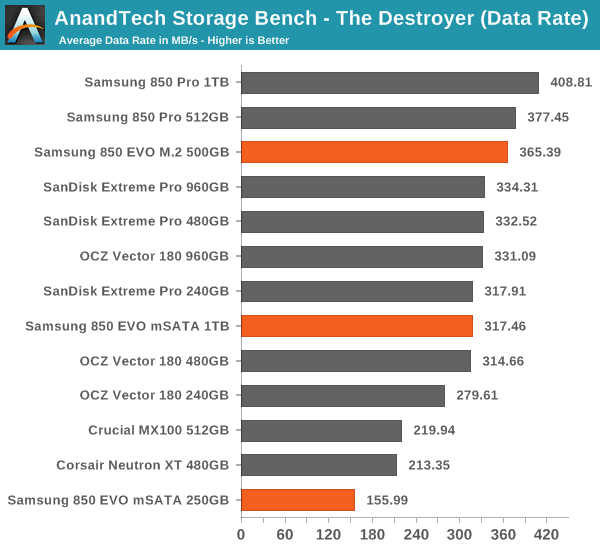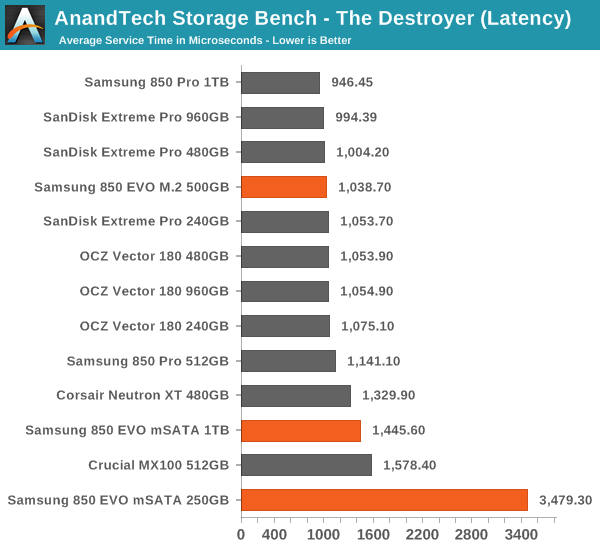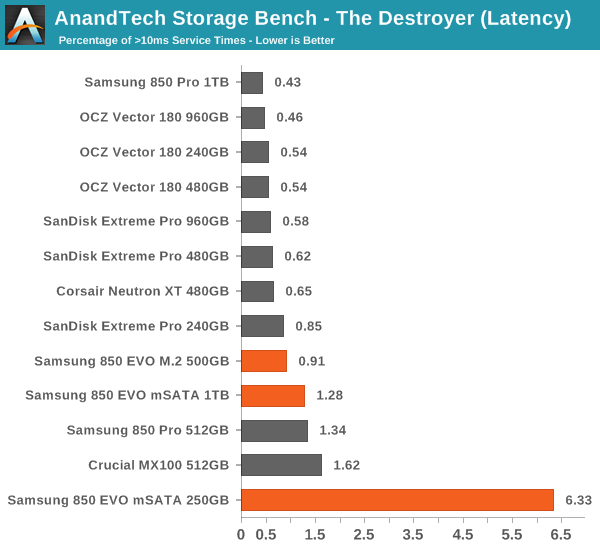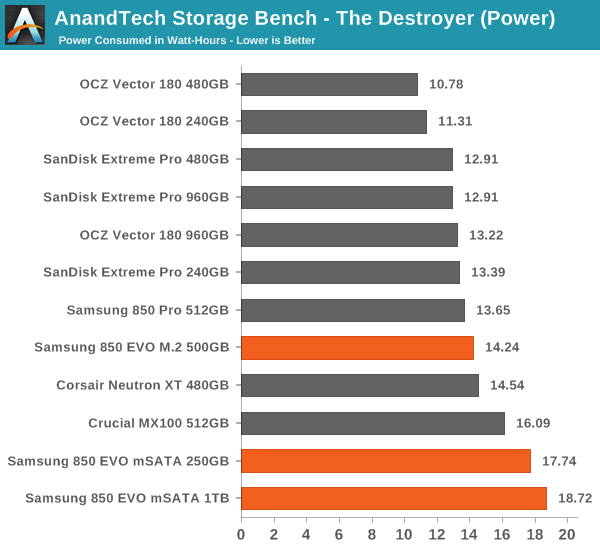The Samsung SSD 850 EVO mSATA/M.2 Review
by Kristian Vättö on March 31, 2015 10:00 AM ESTAnandTech Storage Bench - The Destroyer
The Destroyer has been an essential part of our SSD test suite for nearly two years now. It was crafted to provide a benchmark for very IO intensive workloads, which is where you most often notice the difference between drives. It's not necessarily the most relevant test to an average user, but for anyone with a heavier IO workload The Destroyer should do a good job at characterizing performance.
| AnandTech Storage Bench - The Destroyer | ||||||||||||
| Workload | Description | Applications Used | ||||||||||
| Photo Sync/Editing | Import images, edit, export | Adobe Photoshop CS6, Adobe Lightroom 4, Dropbox | ||||||||||
| Gaming | Download/install games, play games | Steam, Deus Ex, Skyrim, Starcraft 2, BioShock Infinite | ||||||||||
| Virtualization | Run/manage VM, use general apps inside VM | VirtualBox | ||||||||||
| General Productivity | Browse the web, manage local email, copy files, encrypt/decrypt files, backup system, download content, virus/malware scan | Chrome, IE10, Outlook, Windows 8, AxCrypt, uTorrent, AdAware | ||||||||||
| Video Playback | Copy and watch movies | Windows 8 | ||||||||||
| Application Development | Compile projects, check out code, download code samples | Visual Studio 2012 | ||||||||||
The table above describes the workloads of The Destroyer in a bit more detail. Most of the workloads are run independently in the trace, but obviously there are various operations (such as backups) in the background.
| AnandTech Storage Bench - The Destroyer - Specs | ||||||||||||
| Reads | 38.83 million | |||||||||||
| Writes | 10.98 million | |||||||||||
| Total IO Operations | 49.8 million | |||||||||||
| Total GB Read | 1583.02 GB | |||||||||||
| Total GB Written | 875.62 GB | |||||||||||
| Average Queue Depth | ~5.5 | |||||||||||
| Focus | Worst case multitasking, IO consistency | |||||||||||
The name Destroyer comes from the sheer fact that the trace contains nearly 50 million IO operations. That's enough IO operations to effectively put the drive into steady-state and give an idea of the performance in worst case multitasking scenarios. About 67% of the IOs are sequential in nature with the rest ranging from pseudo-random to fully random.
| AnandTech Storage Bench - The Destroyer - IO Breakdown | |||||||||||
| IO Size | <4KB | 4KB | 8KB | 16KB | 32KB | 64KB | 128KB | ||||
| % of Total | 6.0% | 26.2% | 3.1% | 2.4% | 1.7% | 38.4% | 18.0% | ||||
I've included a breakdown of the IOs in the table above, which accounts for 95.8% of total IOs in the trace. The leftover IO sizes are relatively rare in between sizes that don't have a significant (>1%) share on their own. Over a half of the transfers are large IOs with one fourth being 4KB in size.
| AnandTech Storage Bench - The Destroyer - QD Breakdown | ||||||||||||
| Queue Depth | 1 | 2 | 3 | 4-5 | 6-10 | 11-20 | 21-32 | >32 | ||||
| % of Total | 50.0% | 21.9% | 4.1% | 5.7% | 8.8% | 6.0% | 2.1% | 1.4 | ||||
Despite the average queue depth of 5.5, a half of the IOs happen at queue depth of one and scenarios where the queue depths is higher than 10 are rather infrequent.
The two key metrics I'm reporting haven't changed and I'll continue to report both data rate and latency because the two have slightly different focuses. Data rate measures the speed of the data transfer, so it emphasizes large IOs that simply account for a much larger share when looking at the total amount of data. Latency, on the other hand, ignores the IO size, so all IOs are given the same weight in the calculation. Both metrics are useful, although in terms of system responsiveness I think the latency is more critical. As a result, I'm also reporting two new stats that provide us a very good insight to high latency IOs by reporting the share of >10ms and >100ms IOs as a percentage of the total.
I'm also reporting the total power consumed during the trace, which gives us good insight into the drive's power consumption under different workloads. It's better than average power consumption in the sense that it also takes performance into account because a faster completion time will result in less watt-hours consumed. Since the idle times of the trace have been truncated for faster playback, the number doesn't fully address the impact of idle power consumption, but nevertheless the metric is valuable when it comes active power consumption.

The pausing issue of the 1TB 850 EVO mSATA also translates straight to our The Destroyer trace. While higher capacities are usually faster than smaller capacities in this test, the 1TB mSATA is about 15% slower than the 500GB M.2. Generally speaking the 850 EVO does very well at 500GB and above, but since Samsung's TLC V-NAND is 128Gbit in capacity and single-plane, the 250GB can't keep up with drives that are using smaller capacity NAND for higher parallelism.

The latency graph further illustrates the poor performance of the 1TB mSATA, but quite surprisingly the 500GB 850 EVO is actually faster than the 512GB 850 Pro. I suspect the additional over-provisioning helps because The Destroyer is a very intensive trace that practically puts the drive into steady-state .

The share of high latency IOs is a bit high, but nothing to be concerned of. Only the 250GB model has a significant amount of >10ms IOs and for IO intensive workloads I would strongly advise to go with 500GB or higher.

Active power consumption seems to be quite high for the 850 EVO, although I'm not surprised since TLC generally consumes more power than MLC due to its inherent design (more program pulses needed to achieve the final voltage state).











58 Comments
View All Comments
cleverdude - Saturday, April 18, 2015 - link
Bench results have not been updated.http://www.anandtech.com/bench/SSD/65
szhosain - Monday, May 4, 2015 - link
On my Lenovo W530 laptop (about 3 years old now), I just installed a Samsung 850 EVO MSATA 1TB card, and ATTO shows me poorer numbers than seen here. About 267 MB/sec for write and 280 MB/sec for read when it peaks. My 2.5" SSD drives (from OCZ) in the same system are well over 500 MB /sec.Does this perhaps mean that the MSATA interface on this laptop is limited to 3 GB/sec rather than the 6 GB /sec on the standard SATA interfaces?
That would be quite irritating!
Ethos Evoss - Sunday, June 21, 2015 - link
When it comes to mSATA or M.2 connected to SATA III there is no point purchase stupid expensive SSDs as they will perform same as cheapest ones ..So best mSATA/m.2 SSD for SATA III use is the plextor or mushkin (i preffer plextor) which cost less and has great performance
Andrew Field - Wednesday, August 5, 2015 - link
This Samsung SSD 850 EVO mSATA constantly overheats. This is especially the case when copying large files. It rises about 10C every 30-60 seconds, and does not stop until its own overheating protection kicks in. This occurs when it is in a laptop or in an external enclosure (even when open and exposed to the air).Initially I thought I had a bad piece of hardware, but I tested 5 separate units with consistent results.
If anyone decides to test this out, I did the following:
- Step 1: Select a folder with at least 100GB of data
- Step 2: Copy said folder to a new folder (on the same Samsung SSD 850 EVO mSATA)
- Step 3: Monitored the temperature
Result: The temperature begins rising sharply in a few seconds, and does not stop rising until the SSD engages its overheating protection.
greywarden - Thursday, September 17, 2015 - link
I was about to purchase (4) 250GB 850 EVO mSATA drives to put in an Addonics quad mSATA PCIe card, but seeing the latency numbers on the drive has me concerned. Should I look into purchasing a pair of the 500GB models instead? Have the pausing and crashing problems been solved with the 1TB model yet?payamfi - Tuesday, January 19, 2016 - link
Hi guys i wanna buy a memmory for my n551jx i can not decide what to buy msata evo mini or ssd evo pro can anyone help me out?fabbrimichele75 - Friday, March 25, 2016 - link
Would it be possible to know the temperature when the disk is in idle and full load?I'm mainly interested in the M.2 version.
I'm asking because I wanted to mount it on an NUC 6i5 that seems to be sensitive to high temperature.
yolomolo - Tuesday, April 19, 2016 - link
Can i get some advice from you PRO, should i better go get mSata : Samsung EVO 850 or CRUCIAL MX200 ?